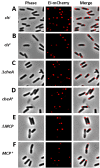The general phosphotransferase system proteins localize to sites of strong negative curvature in bacterial cells
- PMID: 24129255
- PMCID: PMC3812706
- DOI: 10.1128/mBio.00443-13
The general phosphotransferase system proteins localize to sites of strong negative curvature in bacterial cells
Abstract
The bacterial cell poles are emerging as subdomains where many cellular activities take place, but the mechanisms for polar localization are just beginning to unravel. The general phosphotransferase system (PTS) proteins, enzyme I (EI) and HPr, which control preferential use of carbon sources in bacteria, were recently shown to localize near the Escherichia coli cell poles. Here, we show that EI localization does not depend on known polar constituents, such as anionic lipids or the chemotaxis receptors, and on the cell division machinery, nor can it be explained by nucleoid occlusion or localized translation. Detection of the general PTS proteins at the budding sites of endocytotic-like membrane invaginations in spherical cells and their colocalization with the negative curvature sensor protein DivIVA suggest that geometric cues underlie localization of the PTS system. Notably, the kinetics of glucose uptake by spherical and rod-shaped E. coli cells are comparable, implying that negatively curved "pole-like" sites support not only the localization but also the proper functioning of the PTS system in cells with different shapes. Consistent with the curvature-mediated localization model, we observed the EI protein from Bacillus subtilis at strongly curved sites in both B. subtilis and E. coli. Taken together, we propose that changes in cell architecture correlate with dynamic survival strategies that localize central metabolic systems like the PTS to subcellular domains where they remain active, thus maintaining cell viability and metabolic alertness.
Importance: Despite their tiny size and the scarcity of membrane-bounded organelles, bacteria are capable of sorting macromolecules to distinct subcellular domains, thus optimizing functionality of vital processes. Understanding the cues that organize bacterial cells should provide novel insights into the complex organization of higher organisms. Previously, we have shown that the general proteins of the phosphotransferase system (PTS) signaling system, which governs utilization of carbon sources in bacteria, localize to the poles of Escherichia coli cells. Here, we show that geometric cues, i.e., strong negative membrane curvature, mediate positioning of the PTS proteins. Furthermore, localization to negatively curved regions seems to support the PTS functionality.
Figures





Similar articles
-
Spatial and temporal organization of the E. coli PTS components.EMBO J. 2010 Nov 3;29(21):3630-45. doi: 10.1038/emboj.2010.240. Epub 2010 Oct 5. EMBO J. 2010. PMID: 20924357 Free PMC article.
-
The phosphotransferase system (PTS) of Streptomyces coelicolor identification and biochemical analysis of a histidine phosphocarrier protein HPr encoded by the gene ptsH.Eur J Biochem. 1999 Oct 1;265(1):308-17. doi: 10.1046/j.1432-1327.1999.00727.x. Eur J Biochem. 1999. PMID: 10491187
-
Coupling the phosphotransferase system and the methyl-accepting chemotaxis protein-dependent chemotaxis signaling pathways of Escherichia coli.Proc Natl Acad Sci U S A. 1995 Dec 5;92(25):11583-7. doi: 10.1073/pnas.92.25.11583. Proc Natl Acad Sci U S A. 1995. PMID: 8524808 Free PMC article.
-
Catabolite repression and inducer control in Gram-positive bacteria.Microbiology (Reading). 1996 Feb;142 ( Pt 2):217-230. doi: 10.1099/13500872-142-2-217. Microbiology (Reading). 1996. PMID: 8932696 Review.
-
Transcription regulators controlled by interaction with enzyme IIB components of the phosphoenolpyruvate: sugar phosphotransferase system.Biochim Biophys Acta. 2013 Jul;1834(7):1415-24. doi: 10.1016/j.bbapap.2013.01.004. Epub 2013 Jan 11. Biochim Biophys Acta. 2013. PMID: 23318733 Review.
Cited by
-
Bistable forespore engulfment in Bacillus subtilis by a zipper mechanism in absence of the cell wall.PLoS Comput Biol. 2014 Oct 30;10(10):e1003912. doi: 10.1371/journal.pcbi.1003912. eCollection 2014 Oct. PLoS Comput Biol. 2014. PMID: 25356555 Free PMC article.
-
Dash-and-Recruit Mechanism Drives Membrane Curvature Recognition by the Small Bacterial Protein SpoVM.Cell Syst. 2017 Nov 22;5(5):518-526.e3. doi: 10.1016/j.cels.2017.10.004. Epub 2017 Nov 1. Cell Syst. 2017. PMID: 29102609 Free PMC article.
-
Extracellular peptide production in Escherichia coli by inducible downregulation of lipoprotein Lpp via MicL sRNA.Appl Microbiol Biotechnol. 2025 Jun 4;109(1):136. doi: 10.1007/s00253-025-13524-z. Appl Microbiol Biotechnol. 2025. PMID: 40468089 Free PMC article.
-
Comparative Genomics Analysis of Streptomyces Species Reveals Their Adaptation to the Marine Environment and Their Diversity at the Genomic Level.Front Microbiol. 2016 Jun 27;7:998. doi: 10.3389/fmicb.2016.00998. eCollection 2016. Front Microbiol. 2016. PMID: 27446038 Free PMC article.
-
Cryptic-Prophage-Encoded Small Protein DicB Protects Escherichia coli from Phage Infection by Inhibiting Inner Membrane Receptor Proteins.J Bacteriol. 2019 Nov 5;201(23):e00475-19. doi: 10.1128/JB.00475-19. Print 2019 Dec 1. J Bacteriol. 2019. PMID: 31527115 Free PMC article.
References
-
- Nevo-Dinur K, Govindarajan S, Amster-Choder O. 2012. Subcellular localization of RNA and proteins in prokaryotes. Trends Genet. 28:314–322 - PubMed
-
- Govindarajan S, Nevo-Dinur K, Amster-Choder O. 2012. Compartmentalization and spatio-temporal organization of macromolecules in bacteria. FEMS Microbiol. Rev. 36:1005–1022 - PubMed
Publication types
MeSH terms
Substances
LinkOut - more resources
Full Text Sources
Other Literature Sources
Molecular Biology Databases
